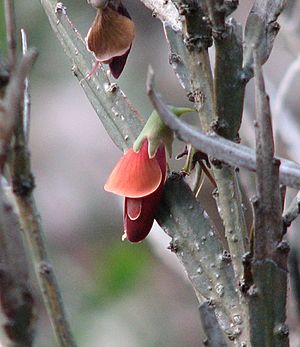Bossiaea facts for kids
Quick facts for kids Bossiaea |
|
|---|---|
 |
|
| Bossiaea walkeri | |
| Scientific classification | |
| Kingdom: | |
| (unranked): | |
| (unranked): | |
| (unranked): | |
| Order: | |
| Family: | |
| Subfamily: | |
| (unranked): | |
| Genus: |
Bossiaea
|
| species | |
|
See text. |
|
| Synonyms | |
|
|
Bossiaea is a group of about 70 different types of flowering plants. These plants belong to the Fabaceae family, which is also known as the pea family. All Bossiaea species grow naturally in Australia.
The genus Bossiaea was named after Joseph Hugues Boissieu La Martinière. He was a botanist who traveled with La Pérouse's expedition to Australia.
Contents
What Are Bossiaea Plants Like?
Bossiaea plants are often shrubs, which are like small, bushy trees. Some can be very small, while others grow taller. Many of them have interesting stems that look like flattened leaves. These are called phyllodes.
Their flowers are usually bright and colorful. They often have the classic "pea flower" shape. This means they have five petals that look a bit like a butterfly. The colors can range from yellow and orange to red and brown.
Where Do Bossiaea Plants Grow?
You can find Bossiaea plants in many different parts of Australia. They grow in various habitats, from forests to sandy areas. Some species are found in specific regions, while others are more widespread.
Cool Bossiaea Species
There are many interesting species within the Bossiaea group. Here are a few examples:
- Bossiaea aquifolium, also known as Water bush, is a type of Bossiaea that grows in certain areas.
- Bossiaea cinerea is sometimes called Showy bossiaea because of its pretty flowers.
- Bossiaea prostrata is a low-growing plant. It spreads out along the ground.
- Bossiaea walkeri is a unique species. It gets its name "Cactus bossiaea" because its stems look a bit like a cactus.
Many other species exist, each with its own special features. Scientists are always learning more about these amazing Australian plants.
See also
 In Spanish: Bossiaea para niños
In Spanish: Bossiaea para niños

